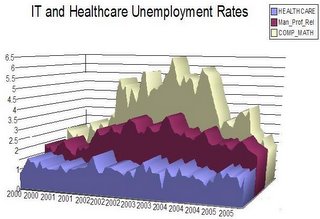Debunking an IT Worker Shortage
By Roy Lawson
Many of my blogs and public statements dispute an IT worker shortage. Today I provide actual government data from the BLS which is both current and complete. I am able to get real-time data from the BLS detailing the unemployment rates gathered during the monthly household survey for the past 5 years. This research comes after months of researching the core problems facing IT workers.
Although I believe the unemployment rates are artificially low, we are making an apples to apples comparison proving that unemployment amongst the Math and Computer (IT) occupations is much higher than the average of professional and managerial occupations, and way higher than healthcare -a third occupation to give you an example of low unemployment and a true "worker shortage". Please view the image below. Note that the blue graph is healthcare, red is average, and beige is computer and math occupations.

As one can clearly see from the end of 2001 and beyond, computer and math occupations had an unemployment rate much higher than average. These high unemployment periods also coincide with higher caps on the H1-B visa. Based upon this knowledge I propose reforming employment based visas so that only occupations with below average unemployment rates are eligible for the visas.
This proposal would prevent companies from replacing American workers with cheaper foreign labor when unemployment rates are high, and would divert those workers to where they are most needed. I would propose an additional "stop-loss" of 3.5%, meaning professional and managerial occupations that rise above that should also be ineligible for employment based visas (H1-B). This would prevent the average unemployment rate from rising too high and would give employers an incentive for retaining their American workers.
Although this would not spell an end to our labor woes because of the latest trend of offshoring, it would provide relief to an especially hard hit occupation. What is unfortunate is that organizations like the ITAA (headed by Harris Miller) argued during the times we faced the highest unemployment rates that there was a "worker shortage". This data proves that argument patently false. It begs to question what data they based their argument on, which we coined "shortage shouting".
*Raw data is available real time at the BLS and can be accessed through their web based series report. The graph above utilized the following series codes across all years:
LNU04034028
LNU04034021
LNU04032215
If you have an interest in the household survey methodology it is here: http://www.bls.gov/cps/eetech_methods.pdf
If you need an explanation on how occupations are classified the data is here: http://www.bls.gov/cps/cpsaat11.pdf

0 Comments:
Post a Comment
<< Home